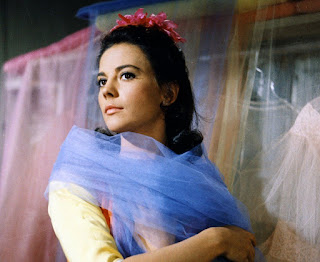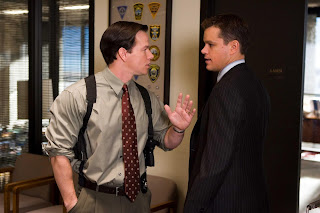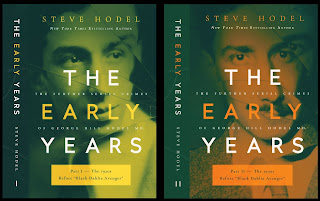
Diane Kruger, Jessica Lange, Adewale Akinnuoye-Agbaje, Alan Cumming, Danny Huston, Ian Hart and Colm Meaney have joined Liam Neeson in noir thriller Marlowe, which is now filming in Ireland and Spain. The script from William Monahan (The Departed) is based on the novel The Black-Eyed Blonde by John Banville, with Oscar winner Neil Jordan (In Dreams) aboard to direct. In Marlowe, when private detective Philip Marlowe (Neeson) is hired to find the ex-lover of a glamorous heiress, it looks an open and shut case, but Marlowe soon finds himself in the underbelly of Hollywood’s film industry and unwittingly drawn into the crossfire of a legendary Hollywood actress and her subversive, ambitious daughter. Kruger will play Clare Cavendish, the femme-fatale instigator of the plot, who inherits her irresistible charm from her notorious mother, Dorothy Cavendish, played by Oscar winner Jessica Lange. Hart is set to play detective Joe Green, whilst Colm Meaney plays Bernie Ohls, the DA’s investigator and Chandler’s other recurring character from the original stories. Danny Huston will play the colourful country club manager, Floyd Hanson. Akinnuoye will play Cedric, the right-hand to sharply-dressed gangster Lou Hendricks, played by Cumming. Source: deadline.com

In a 1945 essay, Edmund Wilson, America’s premiere man of letters in the 1940s, singled out Raymond Chandler's hard-boiled fiction for grudging praise. Dismissing the novels of Dashiell Hammett as little more than a comic strip, Wilson saw Chandler’s value as atmospheric: “It is not simply a question of a puzzle which has been put together but of a malaise conveyed to the reader, the horror of a hidden conspiracy that is continually turning up in the most varied and unlikely forms.” Chandler, who regarded Wilson as the kind of snobbish intellectual he despised, agreed. Chandler was clear-eyed about the reason Hollywood studios had hired him. He knew it was because of the atmosphere he gave to screenplays. Robert Towne cited Chandler’s description of California as the inspiration for his Academy Award-winning script for the neo-noir film Chinatown.

Ridley Scott and screenwriter Hampton Fancher summoned Chandler when they made the future-noir Blade Runner, with its burn-out, alcoholic detective played by Harrison Ford amidst a rain and pollution-drenched Los Angeles. Chandler was not crazy about The Big Sleep (he thought he ran his trademark similes into the ground). Nevertheless, the editors of this Black Lizard’s new annotated edition of The Big Sleep, Pamela Jackson and Anthony Dean Rizzuto, regard the novel as a masterpiece. Chandler considered himself “an intellectual, as much as I dislike the term.” Although he followed the prejudices of his day when dealing with gay characters (in The Big Sleep he called homosexuals “queens” and “fags), unlike other mystery novelists of his era, Chandler didn’t always follow the noir theme of a good, honest man seduced and then brought down by a femme fatale.
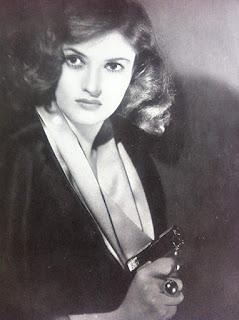
By contrast, his female characters were sometimes perverted and insane, like the certifiable nymphomaniac Carmen Sternwood in “The Big Sleep” who, when angered, hissed through her animal-like teeth. Throughout almost all of the novels, Marlowe, in pursuing the task he was hired for, discovers along the way a much bigger crime. In
The Big Sleep, Chandler was hired to muscle a blackmailer away from the Sternwood family. But he learns what actually happened to the father’s best friend, Rusty Reagan. Reagan didn’t run off. He was murdered by the spurned Carmen. Critics have often characterized Chandler’s plots as confusing. Chandler himself had no real interest in plotting. But read carefully, his novels did have a distinctive and pioneering plotting. In 1950, Chandler admitted modestly in a letter: "As I look back on my stories it would be absurd if I did not wish they had been better. But if they had been much better they would not have been published." “Chandler wrote like a slumming angel and invested the sun-blinded streets of Los Angeles with a romantic presence,” said crime novelist Ross Macdonald—author of
The Way Some People Die (1951)
, reviewed by The New York Times as: “The best novel in the tough tradition I've read since
Farewell, My Lovely and possibly since
The Maltese Falcon.” The Chicago Tribune stated
:“Ross Macdonald gives to the detective story that accent of class that Raymond Chandler did. His enduring virtue is compassion.” John Sutherland, emeritus professor at University College London, stated: “Raymond Chandler qualifies as the Marcel Proust of the hard-boiled detective novel.”
Frank McShane wrote the first biography of Raymond Chandler:
The life of Raymond Chandler in 1986.
A Mysterious Something in the Light: The Life of Raymond Chandler (2012)
is an interesting study by Tom Williams, an excellent examination of Chandler's personality and also provides insight into his style of writing. Judith Freeman investigated—in
The Long Embrace: Raymond Chandler and the Woman He Loved (2008)—Chandler's romance and long marriage with Cissy Pascal. The final chapters are especially heartbreaking following Cissy’s death as Chandler spirals out of control. He’s rarely sober and while he’s often in and out of rehab facilities. Romances were attempted—notably Helga Greene, his literary agent and Jean Fracasse, his secretary—but eventually failed as he was never able to get over the loss of Cissy. His crippling loneliness leads to suicide attempts and cries for help before he ultimately passes away following a bout with pneumonia. "What a man wants and needs... and surely a woman too, is the feeling of a loving presence in the home, the tangible and ineffable sense that a life is shared," wrote Chandler in one of his letters, unveiled by Freeman. "To take care of Cissy. That was his driving life force," Judith Freeman concludes. Chandler turned himself into a crime writer for supporting his wife, while feeling he never "wrote a book worthy of dedicating to her."
Many transgressors in Chandler’s novels are women—Carmen Sternwood, Velma Valento, Elizabeth Murdock, Mildred Haviland, Orfamay Quest, Eileen Wade—and all of them are helped by Marlowe to avoid punishment for their various crimes, deceptions, and misdemeanors. Some of Marlowe’s closest personal acquaintances in the novels are women, such as Anne Riordan and Linda Loring. Chandler acknowledged: “I don’t mind Marlowe being a sentimentalist because he always has been. His toughness has always been more or less a surface bluff.” In
The Long Goodbye, Marlowe shows tenderness after spending the night with Linda Loring, Chandler writes: "We said goodbye. I watched the cab out of sight. I went back up the steps and into the bedroom and pulled the bed to pieces and remade it. There was a long dark hair on one of the pillows. There was a lump of lead at the pit of my stomach. To say good-bye is to die a little." This scene demonstrates that Marlowe is perfectly capable of displaying genuine affection for women, a feature that is evident in his friendships with Merle Davies, Anne Riordan, and his marriage to Linda Loring in the unfinished
Poodle Springs (1958). But while Marlowe may occasionally place women on a pedestal, he nevertheless recognizes, unlike other “traditional” hard-boiled detectives, their democratic human value and social parity; a distinct departure from either the highly sexualized femme fatale—for example, Cora in James M. Cain’s
The Postman Always Rings Twice, or Effie Perrine in Hammett’s Sam Spade novels. Marlowe demonstrates this empathy when responding to Terry Lennox’s complaint about “women screwing up their faces and tinkling their goddam bracelets and making with the packaged charm.” Marlowe simply replies by saying, “Take it easy. So they are human. What did you expect—golden butterflies hovering in a rosy mist?”
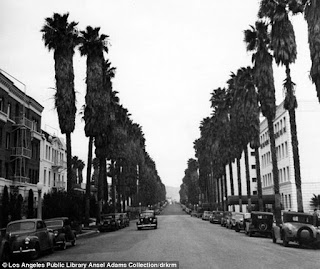
Wallace Stegner once referred to California as “America only more so.” Interestingly, the politically correct of Chandler’s day, the American Communist Party, claimed Chandler as an authentic proletarian novelist. In response, Chandler revealed himself to be more politically astute than the dutiful Marxist Dashiell Hammett. In a series of excellent letters—Chandler was as good at correspondence as he was with fiction—he informed the left that Marlowe didn’t hate the “rich because they take baths.” He hated them because they were “phony.” Politically, Chandler had no sacred cows. He denounced J.Edgar Hoover as inept and dangerous. He bashed the Catholic Church for having “fascist” tendencies. Yet he also was highly critical of Communism. Indeed, in his estimation, Catholicism came off better. Unlike Communists, they were capable of “internal dissent,” and in a typically pithy passage, he wrote that priests didn’t “shoot you in the back of the head for being 48 hours behind the Party line.”
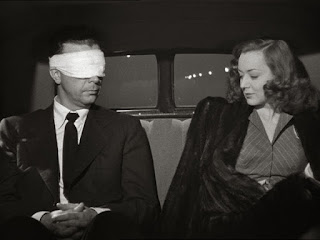
Dmytryk's
Murder, My Sweet and Hawks'
The Big Sleep not only simplify Chandler's novels but also defuse Chandler's social critique, transforming plot and adapting characters when not eliminating them outright. Chandler was equally critical of other writers. For example, he lamented Hemingway’s poor performance in the late 1940s. James M. Cain, the author of the novel
Double Indemnity that Chandler adapted for the screen, was akin to a pornographer. Chandler did, however, praise some writers such as Somerset Maugham, who set the gold standard for spy novels. And he was particularly admiring of F. Scott Fitzgerald. Fitzgerald and Chandler make an interesting comparison. Although Fitzgerald had a much more rosey-eyed view than Chandler, both were capable of poetic atmosphere. Toward the end of his life, Chandler came to feel that L.A. had become a grotesque and impossible place to live. It was a “jittering city,” sometimes dull, sometimes brilliant, but always depressing to him. In his later years, Chandler commented that he felt L.A. had completely changed in the years since he’d arrived. Even the weather was different. “Los Angeles was hot and dry when I first went there,” he said, “with tropical rains in the winter and sunshine at least nine-tenths of the year. Now it is humid, hot, sticky, and when the smog comes down into the bowl between the mountains which is Los Angeles, it is damned near intolerable.”
Source: www.judithfreemanbooks.com
Raymond Chandler was otherwise described, in the course of his life, as cynical and gullible; reclusive and generous; depressive and romantic; proud and paranoid. Two things stabilized him. Being drunk, which he often was, and Philip Marlowe. Described by Evelyn Waugh in the late 1940s as no less than ‘the greatest living American novelist’, he was admired by the likes of T. S. Eliot, W. H. Auden and Edmund Wilson. At Dulwich, he was outstanding at mathematics. (This was a proficiency Chandler shared with the two other most famous crime writers of his generation: Georges Simenon and Dashiell Hammett.) On the basis of his short apprenticeship at the Admiralty and his proficiency at mathematics, Chandler decided on accountancy.

Black Mask was a pulp magazine which had been set up by two New York editors in 1920 to support the lossmaking but prestigious literary magazine Smart Set. The connection with Smart Set – whose most famous contributor was F. Scott Fitzgerald – was an ironic one for Chandler. What was even more inspiring for Chandler was that, despite his respect for Dashiell Hammett (he met him once at a Black Mask dinner in LA), he did not consider Hammett to be an especially good writer: ‘What he did he did superbly,’ decided Chandler, ‘but there was a lot he could not do. For all I know, Hemingway might have learned something from Hammett.’ "Marlowe was an idealist," Chandler admitted, ‘he hates to admit it, even to himself.’ Here was a tough, independent character with an acute and almost constant sense of life’s absurdity. "The Lady in the Lake" (1943) continued to show Marlowe’s frustration, showing Marlowe and Chandler at their most misanthropic. Of all the towns that he and Cissy flitted between,

Big Bear Lake was still Chandler’s favourite, though. ‘Marlowe would lose something by being promiscuous,’ said Chandler. ‘I know he can’t go on forever saying no the way he does – the guy’s human – he’ll have to break sometime but I’ve never wanted the sex bit to dominate either him or the story.’ Chandler would remain grudgingly fascinated by Hollywood even after he had left Los Angeles. "Anyone who doesn't like Hollywood is either crazy or sober," he once wrote. Chandler thought American critics were suffering from ‘pseudoliterate pretentiousness.’ Intellectuals had no dreams left to offer people, he said, and were embarrassed by any emotion other than disappointment: "An age which is incapable of poetry is incapable of any kind of literature except that cleverness of a decadence". Of Graham Greene’s "The Heart of the Matter", Chandler remarked that it had everything that made a good book ‘except verve, wit, gusto, music and magic’. Eugene O’Neill was ‘utterly artificial’; Osbert Sitwell was ‘an Edwardian who stayed up too late’; and the critics who fawned around T. S. Eliot were sterile neurotics looking for ‘stale cake’ to ‘wrap up in a fancy name and sell to the snob-fakers’. Chandler believed that the entire intellectual establishment was in a state of terminal self-delusion, cut off from the public it despised. Such people thought they could write, he said, ‘because they have read all the books’, but they were in fact hacks. ‘There is more life in the worst chapter Dickens or Thackeray ever wrote, and they wrote some pretty awful ones’. Chandler thought Communism was just a ‘fashion’ in America and ‘just as corrupt as Catholicism underneath.’ Suspicious as he was of most institutions, Chandler was politically non-partisan. The trouble was, he believed, that post-war Western culture was being controlled by the first generation of highbrows not to have a grounding in the classics. Without God and without heroes, it was a generation that admired the art of writing itself rather than writing about things that meant anything. Nervous fashion had replaced wisdom. ‘The critics of today’, he told Charles Morton, ‘are tired Bostonians like Van Wyck Brooks or smart-alecks like Fadiman or honest men, confused by the futility of their job, like Edmund Wilson.’ They were all hooked on syntax and pessimism, ‘the opium of the middle classes’.

“She was the beat of my heart for thirty years. She was the music I heard faintly at the edge of sound,” Chandler wrote at the time Cissy died in 1954. "I always opened the car door for her and helped her in. I never let her bring me anything. I always brought things to her. I never went out of a door or into before her. I never went into her bedroom without knocking. I suppose these are small things – like constantly sending her flowers, and always having seven presents for her birthday, and always having champagne on our anniversaries. They are small in a way, but women have to be treated with great tenderness and consideration – because they are women". (Chandler's letter to Deirdre Gartrell, 1957). In letters to Blanche Knopf, Chandler argued that one of Hemingway’s biggest problems was that “ninety per cent of his writing is self-imitation. He never really wrote but one story. All the rest is the same thing in different pants—or without pants. And his eternal preoccupation with what goes on between the sheets becomes rather nauseating in the end”. In a previous letter to Hamish Hamilton in 1951, Chandler expressed his thoughts about F. Scott Fitzgerald: "Fitzgerald is a subject no one has a right to mess up. Nothing but the best will do for him. If the poor guy was already an alcoholic in his college days, it’s a marvel that he did as well as he did. He had one of the rarest qualities in all literature, a real distinction, the word is charm – charm as Keats would have used it. Who has it today? It’s not a matter of pretty writing or clear style. It’s a kind of subdued magic, controlled and exquisite, the sort of thing you get from good string quartets. Yes, where would you find it today?"
"The little blonde at the PBX looked at me expectantly, her small red lips parted, waiting for more fun. I didn't have any more. I went on out... Crystal Kingsley moistened her lips and held her head on one side, staring at me fixedly. There was a quiet little silence. The damp breath of the Pacific slid into the room around us." -"The Lady in the Lake" (1943). Chandler was a romantic, more like F. Scott Fitzgerald than the worldly Hammett, and through the character of Marlowe he became a haunting poet of place, this place, Los Angeles, whose split personality of light and dark mirrored Chandler's own. To a correspondent who suggested that Marlowe was immature, Chandler replied sharply that if being in revolt against a corrupt society was immature, then Marlowe was extremely immature. The influence of Chandler is far beyond a detective novelist (he admired Dickens, Flaubert, Fitzgerald). Chandler was admired by W. H. Auden, Albert Camus, Graham Greene; modern story-tellers as Ross McDonald owe him a hefty debt; Frank Miller,
Sin City novels' author, described Dwight McCarthy as a 'modern iteration of Philip Marlowe.'
“I wouldn't say she looked exactly wistful, but neither did she look as hard to get as a controlling interest in General Motors.” —“Playback” (1958). For Fredric Jameson (in his essay
Raymond Chandler: The Detections of Totality) the artistic accomplishment of Chandler’s work appears to be its formal evocation of 'the big sleep' itself: “It is this opening onto the not-world, onto its edge and its end, in the void, in non-human space, in death, that is the ultimate secret of Chandlerian narrative.” Richard Slotkin nevertheless holds to the old paradigm and overemphasizes the Western provenance of the hardboiled detective as exemplified by Marlowe. He posits, intriguingly, for example, that Chandler's detective, like James Fenimore Cooper's Hawkeye, is first and foremost a "rescuer" of the innocent, that both heroes are "engaged in unmasking hidden truth." In response to one of Mousy Orfamay's complaints in "The Little Sister" about the evils of Los Angeles, Marlowe simply says that "we have to take the bad with the good in this life", an offhand, sarcastic comment that neatly sums up the detective's philosophy. And by guardedly engaging the citizens of the city, he avoids the opposite extreme of nihilism as found in Hammett. One might then expect Chandler's class bias to have endeared him to a Marxist critic such as Ernest Mandel, who, however, feels that Marlowe, among other detectives, is a sentimentalist who wastes his energy on pursuing criminals who wield only "limited clout". It is doubtless Chandler's reluctance to make any global condemnation of the capitalist system that bothers Mandel. Chandler consistently and symbolically sought redress for social ills within the democratic system as he knew it in the United States, within the liberal tradition. In "The Simple Art of Murder," for example, he insisted that no social or political hierarchy is truly divorced from the "rank and file" in a democracy, and thus cannot be completely blamed for its failures.
Ross Macdonald's primary criticism of Chandler is that he is too moralistic; Like other critics, Macdonald misreads Chandler's "The Simple Art of Murder," overemphasizing Chandler's call for "a quality of redemption" as a "central weakness in his vision" in novels. Chandler isolates his hero, Philip Marlowe, by means of "an angry puritanical morality" and erects barriers, including those of language. Chandler's deepest concerns - his interest in the community as well as the individual, his hatred of the abuse and the abusers of power, his conviction that ethical conduct cannot be reduced to simplistic formulae and must be continually scrutinized - are inevitably what Hollywood was most concerned to change for the screen. While classics of film noir and exciting, entertaining narratives in their own right, Dmytryk's
Murder, My Sweet and Hawks'
The Big Sleep not only simplify Chandler's novels but also defuse Chandler's social critique, transforming plot and adapting characters when not eliminating them outright. In an interview about why he cast Dick Powell, Dmytryk said: “Dick Powell fit the character, as far as I could see. After all, what is Marlowe? He’s no Sam Spade. He’s an eagle scout among tough guys. He’s a moral, ethical man, with a strong sense of responsibility.”
The detective is reconfigured as a Lost Generation character in a hard-boiled crime fiction setting. Marlowe has the appearance of an ordinary yet unusual man trying to restore what he perceives as the balance between “good” and “evil,” often ending with him “trying to mete out simple justice.” In a world in which the police are as guilty of egregious violence as criminals, Marlowe roundly condemns both; his toughness is measured not by resorting to such extreme measures, but by his refusal to respond violently to the threats of gangsters (Eddie Mars in
The Big Sleep, Laird Brunette in
Farewell, My Lovely) or the police (Christy French in
The Little Sister, Detective Dayton in
The Long Goodbye). Raymond Chandler's funeral in 1959 was attended by only 17 people, a sad but in some ways appropriate end for a man who had never gone out of his way to make friends.
"I turned west on Sunset and swallowed myself up in three lanes of race-track drivers who were pushing their mounts hard to get nowhere and do nothing. "I used to like this town," I said, just to be saying something and not to be thinking too hard. "A long time ago. There were trees along Wilshire Boulevard. Beverly Hills was a country town. Westwood was bare hills and lots offering at eleven hundred dollars and no takers. Hollywood was a bunch of frame houses on the interurban line. Los Angeles was just a big dry sunny place with ugly homes and no style, but goodhearted and peaceful. It had the climate they just yap about now. People used to sleep out on porches. Little groups who thought they were intellectual, used to call it the Athens of America. It wasn't that, but it wasn't a neon-lighted slum either." -"The Little Sister" (1949) written by Raymond Chandler
Cynthia S. Hamilton insists that, in keeping with the genre, "Chandler's misanthropy demands an absolute separation between Marlowe and the moral squalor of his society". In her view Marlowe is antisocial, an "alienated outsider who vindicates that stance by his demonstrable superiority in a society unworthy of his services." Chandler took on the daunting challenge of using the highly individualistic figure of the private eye to explain how and why American rugged individualism has failed. Chandler reserved his bitterness and contempt for society as a whole and those who occupied the upper echelons in society in particular, whom he considered “phoney.” As Marlowe says in
The Big Sleep, “To hell with the rich. They make me sick.” Roy Meador observed the disillusioned affinity between Chandler's
The Big Sleep and John Steinbeck’s
The Grapes of Wraith, also placing them alongside Nathanael West’s
The Day of the Locust; all of which were published in 1939. However, of these novels, Meador argues that
The Big Sleep is by far the most popular because as a character, “Marlowe encompasses the others and reaches out to new dimensions”. -"Raymond Chandler's Philip Marlowe: The Hard-Boiled Detective Transformed" by John Paul Athanasourelis (2011)

